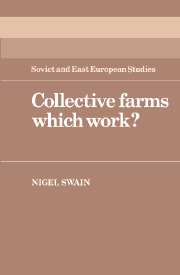Book contents
- Frontmatter
- Contents
- Preface
- Introduction
- PART I ‘FAMILY LABOUR’ AND ‘SOCIALIST WAGE LABOUR’ IN HUNGARY'S CO-OPERATIVE AGRICULTURE: THE INCORPORATION OF PETTY COMMODITY PRODUCTION
- PART II MEMBERS AND MANAGERS
- 3 The social composition of the agricultural producer co-operative labour force
- 4 Professional management on agricultural producer co-operatives: genesis and social characteristics
- PART III MANAGERIAL CONTROL IN AGRICULTURE
- Conclusion
- Appendix I The transformation of Hungarian agriculture
- Appendix II Ancillary enterprises within agricultural co-operatives: number of units engaged in non-agricultural activity
- Notes
- References and bibliography
- Index
4 - Professional management on agricultural producer co-operatives: genesis and social characteristics
Published online by Cambridge University Press: 10 December 2009
- Frontmatter
- Contents
- Preface
- Introduction
- PART I ‘FAMILY LABOUR’ AND ‘SOCIALIST WAGE LABOUR’ IN HUNGARY'S CO-OPERATIVE AGRICULTURE: THE INCORPORATION OF PETTY COMMODITY PRODUCTION
- PART II MEMBERS AND MANAGERS
- 3 The social composition of the agricultural producer co-operative labour force
- 4 Professional management on agricultural producer co-operatives: genesis and social characteristics
- PART III MANAGERIAL CONTROL IN AGRICULTURE
- Conclusion
- Appendix I The transformation of Hungarian agriculture
- Appendix II Ancillary enterprises within agricultural co-operatives: number of units engaged in non-agricultural activity
- Notes
- References and bibliography
- Index
Summary
In this chapter we flip the coin. The development of two types of labour on co-operative farms and its stratification into the broad groups outlined in the previous chapter were associated with the birth of separate groups of organisers of labour and an increasingly complex internal differentiation amongst them. The chapter considers the emergence of a concept of farm management out of the communal ‘family economy’ of the early co-operative farms and the growth of a management which became increasingly ‘credentialist’ (that is, restricted to those holding prescribed minimum educational qualifications) and technologically oriented. It documents this change and then focuses on aspects of the social background and work-situation of the new managers that set them apart from members employed in manual labour. Despite having similar social roots, this new professional management is highly educated, tends to be young because it consists of a new generation performing new jobs, and has a pattern of career mobility generally associated with hierarchical, administrative structures. In future years, when the new managers grow older and the overall membership grows younger as the ‘bulge’ of the generation which experienced collectivisation retires and dies, the particular form of ‘credentialism’ associated with managerial posts will ensure that the educational and political exclusiveness of management is maintained beyond any equalisation in age groups. This difference in career prospects between managerial and manual members has implications for their respective work-situations and, ultimately, their class position.
This development is not surprising, but it was not inevitable. Management within collectivised agriculture could have evolved differently. We have already seen that part of the success of establishing collectivised agriculture between 1959 and 1961 was due to the readiness of the central authorities to let farms elect their own local (often middle peasant) presidents (see chapter 1).
- Type
- Chapter
- Information
- Collective Farms which Work? , pp. 114 - 130Publisher: Cambridge University PressPrint publication year: 1985



